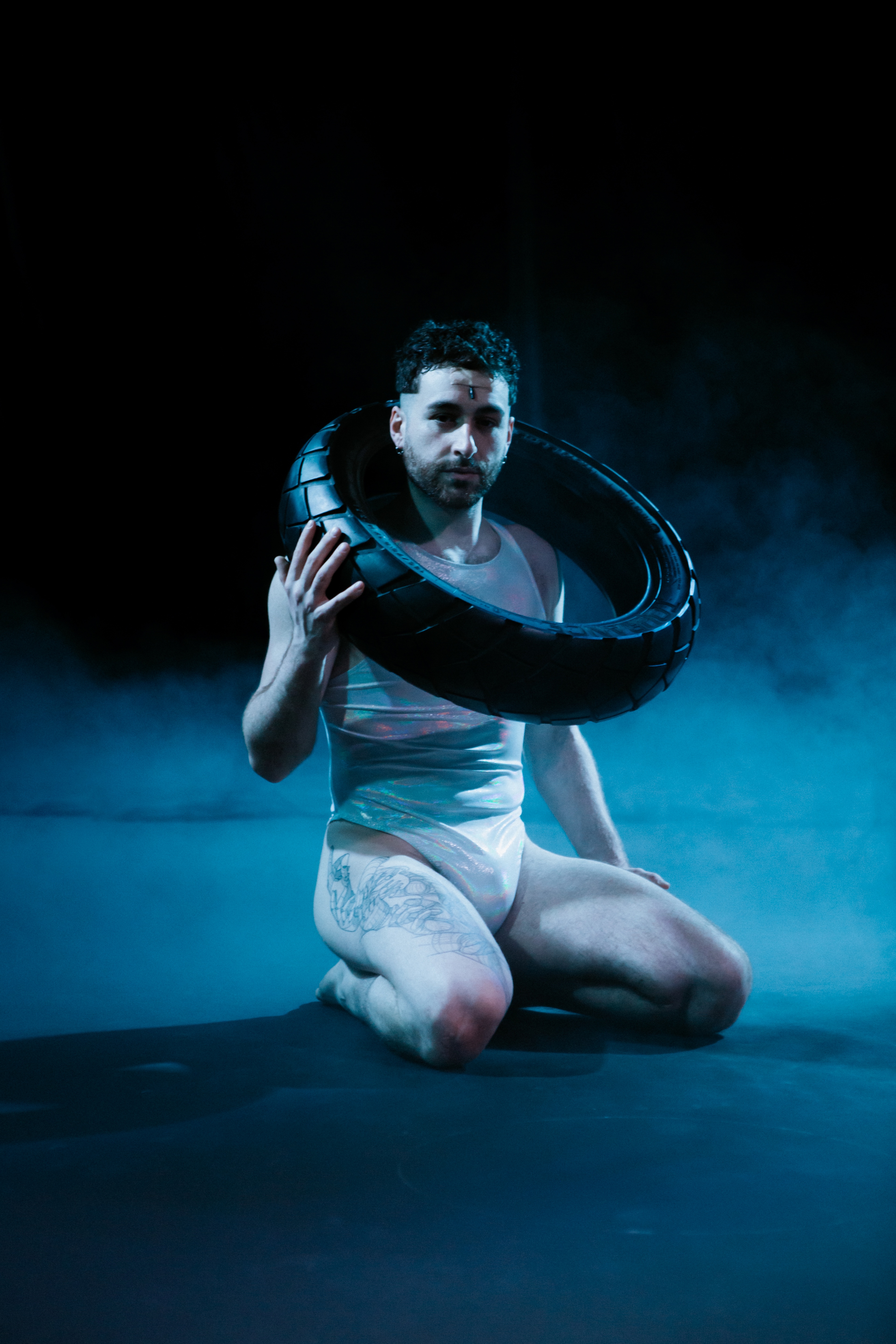Words by Sunhi Keller. Performed at Rich Mix on 16 May.
Amidst a chatty audience and an empty stage, Tommaso Petrolo struts onto the floor, dressed in a holographic leotard — designed by Emma Lyth — and grasping a car tire in his left palm. Instantly, Petrolo captivates the audience with his strong contrapasso stance and silent stare as he spends time making eye contact with each viewer sitting in front of him. He begins to produce guttural noises while repeating the words “obey little, resist much” from Walt Whitman’s poem Caution, which protests enslavement. Petrolo pushes through different vocal capacities, drawing out certain syllables and tripping over others, almost as if he were a human beat box. Soon, a metal soundtrack joins his vocalisations as the light behind him flickers on and off the beat. Petrolo’s volume and intensity grow into a climax, the sounds becoming urgent and frenzied. Suddenly, the music and flashing lights cut out and Petrolo falls into silence, once again staring at the audience members one by one, confronting and challenging their reactions.
In Realness, a solo performed by Tommaso Petrolo and choreographed by Dam Van Huynh, is a highly captivating, emotional and explicit work that challenges how we situate ourselves within (out) our society. Inspired by the events of war and his own perspective as a queer Vietnamese artist, Huynh uses libretto (quoting from Whitman, Audre Lorde, Pussy Riot, Alok Vaid-Menon, and Henry David Thoreau), sound (composed by Ian Tang and engineered by Michael Picknett), lights (designed by Patricia Roldán Polo), and movement to create a performance-protest against violence perpetuated against countries and citizens, other and self.
This struggle between responsibility to community and desire for boundless self-expression is embodied in Petrolo as he fashions the tyre around his waist and thrashes around, performing acrobatics and mimicking acts of sexual nature — he thrusts his pelvis, omits groans of erotic ecstasy, and spanks himself across his butt cheeks. The tyre is a heavy weight attached to him; one he cannot seem to rid himself of. It is both pleasure and pain, both bondage and freedom. Strobe lights decorate the space as Petrolo whips his head back and forth, the thrashing movements slowly traveling down different parts of his body that pushes him into a crawl upstage where he attempts over and over again to perfect a handstand. Once there, Petrolo quotes Thoreau’s words on an anti-government: “the best form of government is no government at all and that is what we’ll have when we are ready for it,” his upside-down position mirroring the resistance of his words — anti-gravity, anti-governed body.
Towards the middle of the piece, Petrolo lifts the tyre onto his shoulders behind his head. The lights create a silhouette of his figure while simultaneously depicting a shadow, almost biblical, on the floor in front of him — the tyre replicates that of a halo over a holy medieval figure as he stands with legs apart, his presence taking over the entire stage. When Petrolo slowly lowers himself down into the splits, an applause track signifies his accomplishment. The lights fade to black and Petrolo reappears weightless, the tire left behind him upstage.

Once free of the heavy tyre, free from the societal pressure of what it means to be a queer man, Petrolo runs and leaps around the space. In an enthralling conclusion, he echoes previous quotes, his voice changing in quality, rhythm and volume. He begins counting down while encouraging both the audience and himself to make a change, repeating variations of “you can do it.” The lights cut as he makes it to “one,” leaving the audience struck in silence, their reflections and questions regarding violence and sexuality, communal responsibility and personal freedoms circling a now empty stage.
Petrolo performs with the intense physicality and passion the choreography demands; yet, despite his captivating, enthralling performance, I did find myself wondering why Petrolo, a white man, was chosen to portray this specific, intensely personal experience. Although I wasn’t privy to the casting decisions, does Huynh’s message change if his story is told through the lens of a white body? Does our interpretation/perception? Many artists of color, myself included, find themselves caught in the tension between accurate representation and artistic freedom, desiring to spotlight the specifics of color, ethnicity, culture while at the same time transcending them.
Amongst the audience, I was moved to reflect on my own personal histories with violence, sexuality and my governed body. As an artist, I respect Van Huynh Company’s artistic vision and choices. And as a part-Asian artist, I resent any expectation (held by popular culture, critic, or even myself) that minority artists should make artwork representing — or “explaining” — minority experiences. Yet, I still find myself questioning, caught in the tension between responsibility to my communities and my desire for artistic freedom. And as both artist and person, I crave seeing someone more like me on stage; there has not been enough space given to Asian voices and bodies.
In that sense, I celebrate Huynh’s work. In Realness, created from his reality and perspective as an Asian artist and queer activist, enriches the conversation about representation and expands that space of what’s possible on stage and in the world.
Header image: Rocio Chacon.
Creative Team
Concept and Choreography: Dam Van Huynh
Performance: Tommaso Petrolo
Composer: Ian Tang
Lighting Design: Patricia Roldán Polo
Costume Design: Emma Lyth
Sound Engineer: Michael Picknett
Photography: Rocio Chacon
